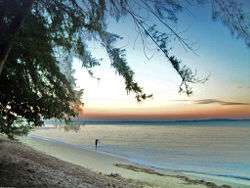Changi
| Changi | |
|---|---|
| Name transcription(s) | |
| • Chinese | 樟宜 |
| • Pinyin | Zhāngyí |
| • Hokkien POJ | Chiuⁿ-gî |
| • Malay | Changi |
| • Tamil | சாங்கி |
|
Sunset at Changi Beach | |
 | |
 Changi Location of Changi within Singapore | |
| Coordinates: 1°23′28″N 103°59′11″E / 1.39111°N 103.98639°ECoordinates: 1°23′28″N 103°59′11″E / 1.39111°N 103.98639°E | |
| Country |
|
Changi is a planning area located in the East Region of Singapore. Sharing borders with Pasir Ris and Tampines to the west, Changi Bay to the southeast, the South China Sea to the east and the Serangoon Harbour to the north, Changi, excluding the two water catchments and islands of Singapore, is the largest planning area by land size.
Today, Changi is an aviation hub. It is the current location of both the Changi Airport and Changi Air Base.
Also located within Changi is Singapore's largest prison, Changi Prison. It became infamous as a Japanese prisoner-of-war camp during the occupation of Singapore in World War II. Changi Prison continues to be Singapore's oldest operating internment facility, in the form of the new Changi Prison Complex.
Etymology
The early Malay place name of Changi was Tanjong Rusa, which is found in the 1604 E.G. de Eredia map of Singapore.
The native place name Changi is found very early in Singapore's history. In the 1828 map by Franklin and Jackson, the extreme southeastern tip of the island is referred to as Tanjong Changi. The local name Changi must have been a significant point for the Malays, especially in the days of the sixteenth century Johor kingdom located on the Johor River. Vessels using the Johor Straits would have to pass by Changi.
There are many versions for the etymological roots of the name Changi. One source says that it comes from a climbing shrub, the changi ular (Apama corymbosa), which grew in the area. Another claims that it gets its name from a tall tree, the chengai (Balanscarpus heimii), which abounded in the area in the early nineteenth century. Changi could also be a variation of the local timber named chengai. This heavy local timber is commonly used for buildings and furniture, and is valued for its strength and renowned for its deep rich colour.
During the early surveys in the 1820s to 1830s of Singapore island, Changi was also named Franklin Point after Captain Franklin who was involved as one of the early surveyors of Singapore island. It would seem that the colonial authorities had decided to latch on their own place name to the existing Malay name for Changi.
Around the 1900s, Changi was the favourite haunt for tigers. The female tigers were said to swim from Johore to Pulau Ubin to rest, before completing their journey to Singapore. The tigers would land at Ferry Point and give birth in this neighbourhood, and so the tigers on the island were generally young.


Economy
Singapore Airlines is headquartered in Airline House, at Changi Airport in Changi.[1] SilkAir also has its head office in Airline House. Singapore Airlines Cargo has its head office in the SATS Airfreight Cargo Terminal 5. Jetstar Asia, Scoot, and Valuair have their head offices in Terminal 1 of the airport. Tiger Airways has its head office in the Honeywell Building in Changi Business Park Central 1[2]
Education
The Japanese School Singapore Changi Campus is in the community.[3]
See also
| Wikimedia Commons has media related to Changi. |
References
- ↑ "Airline Ground Positions." Singapore Airlines. Retrieved on 11 July 2009.
- ↑ "Singapore Air Operators." (Archive) Civil Aviation Authority of Singapore. Retrieved on 31 October 2012.
- ↑ "CHANGI CAMPUS." (Archive) The Japanese School Singapore. Retrieved on 8 January 2014.
Sources
- Victor R Savage, Brenda S A Yeoh (2003), Toponymics - A Study of Singapore Street Names, Eastern Universities Press, ISBN 981-210-205-1
- Cornelius-Takahama, Vernon (16 March 1999), Changi, Singapore Infopedia, National Library Board, Singapore, archived from the original on 2010-01-23, retrieved 2009-07-23 External link in
|publisher=(help)
